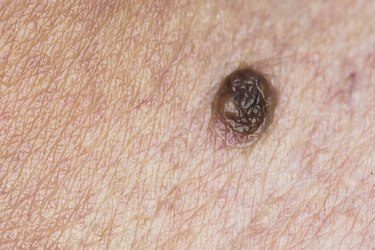
The neem tree, or Azadirachta Indica, is native to South East Asia, in particular India, Pakistan, Bangladesh and Myanmar. Its leaves, seeds and even bark have long been used in these countries as a medicinal cure. Currently, research is being conducted into its healing properties. Neem America, a leading exporter and manufacturer of neem products in the United States, says that neem is used to treat a number of illnesses and medical conditions, including diabetes, pink eye, mouth ulcers, psoriasis, eczema, warts and moles. Neem oil is used in external applications; neem extract and neem leaves can be consumed.
Description
Video of the Day
Neem trees reach a height of up to 100 feet and are characterized by shiny dark leaves of around 12 inches. One of the core ingredient in the neem plant is azadirachtin, which is best known for its pest repellent properties. Neem also contains other biologically active compounds, including ketones, carotenoids and steroids.
Video of the Day
Neem Oil Extraction
Neem extracts contains a concentrated form of the active compound, which is found in leaf, seed and bark. The most common method to remove the oil is by cold pressing, wherein the seed kernels are first crushed to separate the oil from the rest of the husk. Another method is called extracting, whereby the crushed kernels are soaked in an organic solvent like hexane. The latter method might produce inferior oil that is better suited to making soaps and salves rather than used directly to cure warts and itchy moles.
Application
According to the website NeemAmerica.com, neem is known for its effective treatment of viruses, including those causing warts. The compounds in neem absorb the viruses and prevent them from spreading further. To remove moles and warts, it's suggested a drop of undiluted oil be applied directly to the effected area and covered with a small bandage or gauze. The process should be repeated daily for best results, and it may take 2 to 3 weeks of treatments before you begin to see results. The wart will drop off after continuous treatment. In some cases the direct application of pure neem oil on skin can give rise to irritation, redness and a rash. The regular use of neem soaps, creams and lotions can prevent warts from appearing, and neem leaf capsules taken regularly can also keep warts at bay.
Storage
Neem oil should be stored like all oils, in a cool, dark and dry place. If it does solidify, the bottle can be placed in warm water to thaw it out. For best results, do not freeze neem oil or place it in the refrigerator.
Warning
Neem oil in its undiluted form can be extremely strong. It should be used with caution and its not recommended for internal consumption. In its application on warts, only a single drop should be applied at a time as it may cause burning or inflammation. For sensitive skin, dilution with a lighter oil such as grape seed oil is recommended.